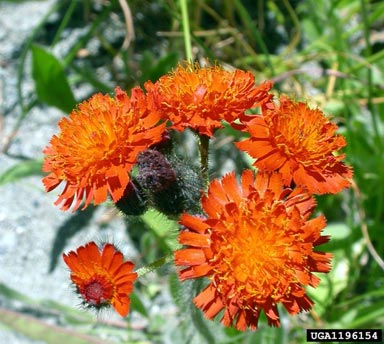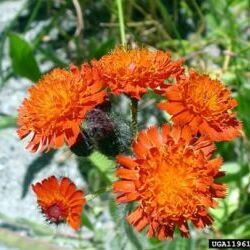
General: Hairy plant with showy clusters of orange flowers.
Height: Grows between 0.3 and 1.3m tall.
Flowers: Flowers grow on the top of a single stem. They are orange and look like dandelion flowers. The petals have notched tips.
Leaves/Stems: Stems are singular and covered in stiff hairs. Leaves grow mostly at the bottom of the plant and are shaped like a spatula. They are also covered in hairs.
Root: There is a woody stem base with a fibrous root system. There are also strawberry-like runners that are a type of root.
Orange-red king devil, Devil’s paintbrush
Orange False Dandelion, Orange agoseris which is a native plant.
Differences: There is only one flower at the top of the native plant whereas on Orange Hawkweed, there are clusters of flowers. The leaves of the native agoseris are generally thinner and lance-shaped but can be quite variable. Agoseris does not have any over the ground runners.
Where did it come from? Introduced from Europe.
Where does it grow here? It grows in BC in low to mid elevations usually in disturbed areas like roadsides, pastures and gravel pits. It can, however, spread into undisturbed forested sites. It is found in many areas of our region especially the side drainages of the Duffy corridor.
Reproduction: Three ways: seed, roots and over the ground runners (stolons).
When does it grow, flower & seed? Sprouts April-May. Flowers June-August. Seeds September.
Spreads By: Equipment used for logging, recreational activities, animals, contaminated hay. The seeds are like dandelion’s but they don’t travel far by the wind.
Plant Type: Perennial.
- Due to the multiple reproduction methods, orange hawkweed can spread quickly taking over disturbed and natural ecosystem areas. This decreases the biodiversity of an area.
- There is a high risk of establishment and spread on forestry roads.
- If planted in a home garden, this plant can take over and be difficult to remove permanently.
- Review your property regularly for this species. Do not plant or trade this plant for your garden.
- Treatment Manual removal of this plant must include all plant parts including the root. Remove small patches before it flowers & sets seed. Unless a site is very small, other treatment methods should be considered.
- Cover bare patches or disturbed soil by planting or seeding with non-invasives.
- Check areas where you have removed invasives for any new plants that year and in future growing seasons.
- Dispose of invasive plants responsibly. Take care with this plant because the runners and roots, if dropped, can grow new plants. Bag them for disposal at the local landfill. Composting and burning is not recommended.
- Contact LRISS for specific treatment recommendations.
E-Flora BC: Electronic Atlas of the Flora of British Columbia.
Southern Interior Weed Management Committee. 2016. Invasive Plants of the Southern Interior BC. 86pgs.
Okanagan Invasive Species Online website.
